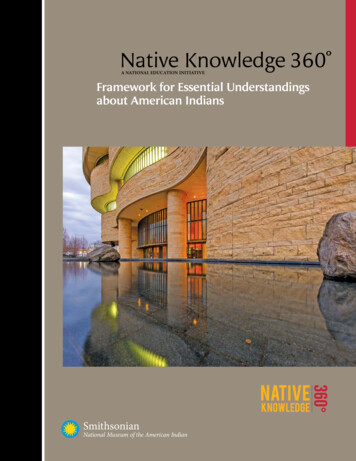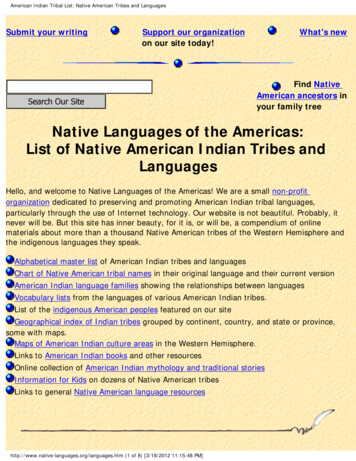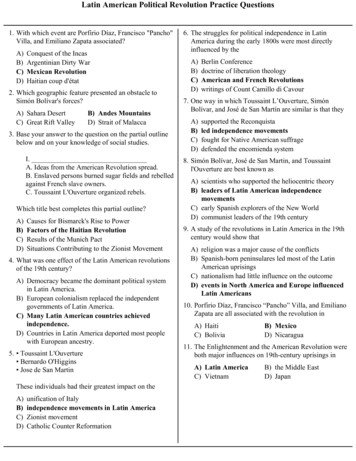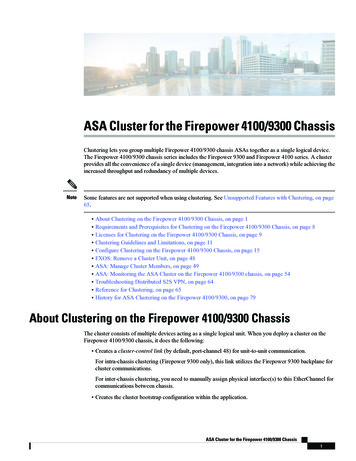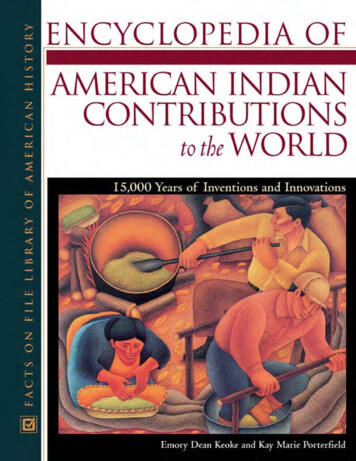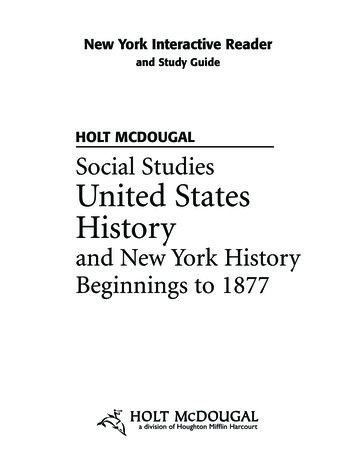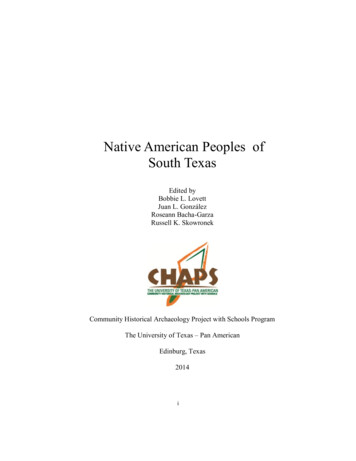
Transcription
Native American Peoples ofSouth TexasEdited byBobbie L. LovettJuan L. GonzálezRoseann Bacha-GarzaRussell K. SkowronekCommunity Historical Archaeology Project with Schools ProgramThe University of Texas – Pan AmericanEdinburg, Texas2014i
Published by CHAPS atThe University of Texas—Pan AmericanEdinburg, TXCopyright 2014 Bobbie L. Lovett, Juan L. González, Roseann Bacha-Garza,Russell K. SkowronekAll Rights ReservedISBN 978-0-615-97674-7No part of this publication may be reproduced, stored in retrieval system, ortransmitted, in any form or by any means, electronic, mechanical,photocopying, recording or otherwise, without the prior permission of thepublisher.Printed in the United States of America.The original cover art was created by Daniel Cardenas of Studio Twelve 01 atthe University of Texas Pan American. The portrait is an amalgamation ofdesign and aesthetic details based on a number of historic nineteenth centuryphotographs of Lipan Apache people provided by Lipan Apache RubenCordva. The surrounding native plants include Agarito, Spanish Daggger,and Texas Kidneywood.ii
Dedicated toDr. Thomas R. HesterPioneering Scholar ofSouth Texas Prehistoryiii
List of Figures and TablesFiguresFigure 1. Coahuiltecan Indians c. 1500. Drawing by JoséCísneros. Courtesy of Museum of South Texas HistoryFigure 2. Deflation TroughsFigure 3. Salt Crystals—Sal del Rey, Edinburg, TXFigure 4. La Sal del Rey, Edinburg, TXFigure 5. Ground Stone Mortar, Rincon, Starr County, TXFigure 6. Petrified Wood Projectile Point, Hidalgo County, TXFigure 7. Outcrop of Goliad Formation, Rio Grande City, TXFigure 8. Geologic EpochsFigure 9. Pieces of El Sauz chert in varying colorsFigure 10. Hammerstones at El Cerrito Villarreal outcropFigure 11. Lipan Apache warriors c. 1500. Drawing by JoséCísneros. Courtesy of Museum of South Texas HistoryFigure 12. South Texas Indian Dancers Intertribal PowwowFigure 13. Lipan Apache Tribe of Texas Tribal ShieldFigure 14. Map of Plains Indians in Texas and North AmericaTablesTable 1. Projectile point chartTable 2. Named Groups Rio Grande Valley Native PeoplesTable 3. Vocabulary from Rio Grande Valley Native PeoplesTable 4. Native Plants and TreesTable 5. How Indians used the Buffaloiv
Table of ContentsAcknowledgements .viPreface viiCh 1. Introduction to South Texas PrehistoryBobbie L. Lovett .1Ch 2. Coahuiltecans of the Rio Grande RegionRussell K. Skowronek and Bobbie L. Lovett 13Ch 3. Wild Food Resources in South TexasMaria Vallejo .23Ch 4. Water, Stone and Minerals: the InorganicResources of South TexasJuan L. González & Federico Gonzalez, Jr .33Ch 5. The Lipan ApachesAshley Leal .45Ch 6. The ComancheAshley Leal .53Ch 7. Native Peoples in Contemporary SocietyAshley Leal 61Ch 8. Native Peoples in the CurriculumRoseann Bacha-Garza and Edna C. Alfaro .69Ch 9. Protecting Archeological Sites: Doing theRight ThingRussell K. Skowronek and Bobbie L. Lovett . 81About the Authors .85References .88v
AcknowledgementsSupport for this research and the wherewithal to produce this book was madepossible through the largess of the Summerfield G. Roberts Foundation ofDallas, Texas and Plains Capital Bank.This work and the CHAPS Program have benefitted greatly from thescholarship and kind comments from Dr. Thomas R. Hester, and Dr. TimothyK. Perttula.Additionally, we wish to thank Donald Kumpe for sharing his insights,collections and connections relating to south Texas prehistory. Thanks are alsodue to J.M. Villareal for providing access to El Sauz chert outcrop on hisproperty in Starr County.Danielle Sekula Ortiz, Roland Smith, John Boland, Thomas Eubanks, Joel Ruiz,Buddy Ross, Victor Paiz, and Carrol Norquest, Jr. for sharing their projectilepoint collections from Hidalgo, Starr, and Zapata Counties and the greaterlower Rio Grande region.Dr. James Hinthorne, Thomas Eubanks, and Nick Morales of the University ofTexas Pan American played an important role in the analysis of the Sauz chert.Robert Soto Vice Chairman, and Ruben and Anabeth Cordova registeredmembers of the Lipan Apache Tribe of Texas were a great aid in research.Thanks are also due to Dr. Lisa Adam and the Museum of South Texas Historyfor their enthusiastic support of the CHAPS Program. We are indeed fortunateto have this world-class institution as our friend.Some of the earlier drafts of the manuscripts contained herein benefitted fromthe editorial skills of Wendy Ramos. Assistance with proofreading andreferences provided by CHAPS graduate assistants Robin Galloso and RolandSilva. Thank you.Many thanks to Rolando Garza, National Park Service Archeologist and Chiefof Resource Management, Palo Alto Battlefield National Historical Park for hison-going support of the CHAPS Program and for obtaining images of localflora and fauna from the U.S. Fish and Wildlife Service.Special thanks are extended to Dr. Cayetano Barrera and Mr. Bill Wilson of D.Wilson Construction for taking time to explore and discuss water resources innorthern Hidalgo County.Thank you to Elisa Flores and Daniel Cardenas at the University of Texas PanAmerican Studio Twelve 01 offices for the cover art and the final production ofthe publication.vi
PrefaceMore than 120 years ago, Frederick Jackson Turnercommented on the closing of the American frontier as a definingcharacteristic of America. Today, “parts unknown” and “terraincognita” are not terms we normally associate with ourknowledge of the modern United States. Over these six scoreyears, the country has been mapped by geographers, its naturalresources have been documented by geologists, and its Nativepeoples, both prehistoric and historic have been studied byanthropologists, archaeologists, and historians. Yet, in somecorners of the country, our knowledge of these aspects of our pastis slim to nonexistent, a tabula rasa. The interior of deep southTexas-Hidalgo, Starr, and Zapata Counties- is one such region.Bounded naturally by the Rio Grande and Nueces rivers,the Gulf of Mexico, and the Edwards Plateau, south Texas is anarea of little water, open grass and brush lands and, until recently,few people. The documentary history of the area dates to the1750s when Spanish colonial communities were established alongthe Rio Grande from Laredo to its mouth near Brownsville.There, ranching and subsistence farming began. In 1900,irrigation transformed southern Hidalgo County into a center forcommercial agriculture. Two decades ago the passage of theNorth American Free Trade Agreement transformed Hidalgo andneighboring Cameron County into manufacturing and transshipment hubs. This spurred great and rapid population growthsuch that lands which only a generation ago grew cotton and citrusnow grow housing developments and related aspects of urbansprawl. As a result of these changes, the preserved aspects of ourpast are being rapidly erased without documentation.In 2009, the Community Historical Archaeology Projectwith Schools (CHAPS) Program was founded at the University ofTexas Pan American to salvage and preserve this rapidly fadingregional history. Through the efforts of CHAPS-affiliated facultyin anthropology, biology, geology, and history, the story of thehuman adaptive experience is being told against changes in thelarger natural and cultural landscape. The program works withvii
teachers and students in K-12 grade levels to inspire a newgeneration to study and learn from the past through oral historyand the scientific study of the local world. This book is one stepin this process.Funded in part through the largess of the Summerfield G.Roberts Foundation as part of a workshop for K-12 teachers, thisbook considers the first people who lived in this region. For morethan ten thousand years, these ancestral Indians or First or NativeAmericans lived along the Rio Grande and Nueces where freshwater was plentiful. Through the endeavors of the CHAPSProgram we now know that the seemingly harsh interior wassuccessfully occupied and necessary resources such as stone andsalt moved widely in the region. The past two centuries witnessedpopulation changes with the arrival of new Native Peoples wholeft their mark on the area. Today, their descendants continue tocall Texas home and share their legacy with the general publicthrough Powwows. Teachers will find in this book and theCHAPS Program web page ways to bring this information to theirstudents.On behalf of the CHAPS Program team I hope your willenjoy The Native American Peoples of South Texas.Russell K. Skowronek, Ph.D.Director of the CHAPS ProgramProfessor of Anthropology & Historyviii
ONEIntroduction to South Texas PrehistoryBobbie L. LovettHumans first occupied south Texas more than 11,000 yearsago (Hester 1980, 2004) and although much has been learnedabout these first Americans in recent years, certain critical aspectsconcerning these peoples still require research. These were thefirst peoples to live in what today we call the Rio Grande region.We do not know their names or the languages they spoke. Theyleft no written records. We know that much later groups known asCoahuiltecans, Lipan Apache, and Comanche lived in the region.It is through archaeology that researchers have been able to tell the“story” of these preliterate and so, “prehistoric” peoples of theregion. Archaeology and its home discipline anthropology arehistorical sciences like biology and geology. It has been throughthe efforts of archeologists using technologies like radiocarbondating, classificatory schema and the careful use of ethnographicanalogy focusing on known peoples that the story of these peopleis beginning to be told.The Late Prehistoric period, the last three or four hundredyears prior to the arrival of the Spanish settlement along the RioGrande, serves as a case in point. The populations knowncollectively as the Coahuiltecans, lived in this area and weredescribed (Kelley 1959:283) as a clearly surviving archaic cultureslightly modified by addition of the bow and arrow. What morecan be said about them?1
The lack of records and information concerning the manygroups that comprise the Coahuiltecans has fostered manyanswered questions: were the mission Indians the cultural andgenetic descendants of an 11,000 year native tradition in southTexas and northeastern Mexico, or were they more recent arrivals,following the buffalo into the area in the 14th and 15th centuriesand remaining as the buffalo populations moved back to the north(Hester 1989:5)? If they were recent arrivals, what of those earlierArchaic peoples in the region? Were they displaced or eventuallyabsorbed? Barring the unlikely revelation of some as yetunknown comprehensive set of documents, answers to thequestions concerning the Coahuiltecans may have to be found inthe archeological record.The Coahuiltecans occupied southern Texas below theEdwards Plateau to the Gulf coast as well as parts of the Mexicanstates of Coahuila, Nuevo Leon, and Tamaulipas east of the SierraMadre Oriental. The area consists of riparian habitats surroundedby thorny brush savanna. The natives, therefore, followed ahunting and gathering existence (Garant 1989:21) which wassubject to regional and temporal variations (Hester 1981:119).Intraregional cultural diversity resulted from spatially- andtemporally-localized resources within the area, and perhapsshifting spheres of extra-areal cultural influences.Hester (1981) suggests two broad adaptive models toexplain the prehistoric cultural patterns that can be observed insouthern Texas. The maritime adaptation found along the southTexas coast consists of a subsistence regime based largely on theresources of the bays, lagoons, barrier islands, the Gulf, and thecontiguous prairie environments. The concentration of resourcesalong the coastal strip afforded their use without the degree ofmobility required in the interior.The savanna adaptation found in the interior reflects theutilization of savanna grasslands and riparian zones. Variations inthe physical environment across the region are likely reflected inthe archeological record in terms of "high resource density" and"low resource density". Low density resources probably resultedin higher group mobility and the subsequent broader dispersal of2
archeological materials. High density probably afforded lessmobility, a seasonal cycle of exploitation, and the reuse ofpreferred campsites situated in locations with varied and abundantresources (Hester 1981:122).Around A.D. 1300-1400, the long-lived Archaic patternended as evidenced by changing settlement patterns and theintroduction of new cultural traits, particularly the bow and arrow,beveled stone knives, and a core-blade lithic technology. This mayreflect adjustments to environmental change associated with aperiod of cooler weather; however, the new cultural inventory isdistinctly different from that of the archaic period (Hester 1975:121). These widespread new cultural similarities are observableover a vast region stretching from north-central and west-centralTexas to deep south Texas, and seem to have emerged in thesouthern Plains and spread southward. Two hypotheses mayaccount for this phenomenon: population movement or culturaldiffusion (Black 1989).The population movement hypothesis posits that peopleoriginating in the southern plains moved into the area, assimilatingor displacing native groups (Black 1989). However, had newgroups moved in, there should be some recognizable evidence ofco-existing native peoples who did not accept the new traits. Aconsideration of the overall picture indicates that the new traits ofthe late prehistoric are widely distributed throughout the savannaarea while the older archaic traits are absent (Hester 1975:122).The cultural diffusion model, marked by the expansionsouthward of the bison range around A.D. 1200-1300 and theinflux of a faunal component largely absent during the Archaicperiod, may offer a more feasible explanation. While the Archaicpeoples of south Texas probably did not become full-fledgedbison hunters, they undoubtedly had to make some readjustmentsin their subsistence system, and perhaps in the placement ofsettlements (Hester 1975:122). Such changes, associated with thearchaeological Toyah Phase to the north, along with a new lithictechnology and tool kit adapted to exploiting bison would havespread relatively uniformly across the entire region in a relativelyshort interval of time (Black 1989).3
With the onset of the Little Ice Age in the fourteenth(1300s) century, the cooling and drying environment encouragedthe bison population to move back to the northern grasslandprairies. As a result, bison were no longer a viable resource forexploitation and it is likely that the ancestral Coahuiltecanpopulations returned to their former successful archaic subsistencepattern. Also, it is likely that the even before the Little Ice Age theenvironment was unable to support large herds of the animals. Asa result, the local inhabitants were not ever solely dependent onthem for their sustenance. Bison hunting did not become sointegral to their lifeway that the bison leaving the area was amatter of great concern. The technology, however, would remain,perhaps to be adapted to some other use within the existingsubsistence system.The environment of south Texas is considered to be aharsh one, even prior to modern times, when it was cooler andmoister. It is a semiarid landscape crossed by rivers and streamswhich offer the only secure sources of water. That is not to saythat people did not venture into the area between the Rio Grandeand Nueces River. In this interior region at water holes, alsoknown as deflation troughs (see González and Gonzalez thisvolume), we find evidence of prehistoric peoples by these resourcenodes. Nonetheless, the rivers and streams acted as funnels for themovement of human and animal populations across the landscape.The riparian environments along their banks provided the foodresources necessary for survival, as well as water. The availabilityof fresh water is an all important factor in survival. It is thereforelikely that any records of human habitation or land use will befound within a certain distance of water sources. It is further likelythat these groups did not wander at random along the rivers andstreams, isolated from contact with others. As Taylor (1964:199)suggests, not only did water have to be a dependable resource,there also had to be some sort of assured recognition of ownership,or right of preemptive use between the varied groups that laidclaim, either formally or informally, to the surrounding territory. Itis not difficult to envision a network of information and goods thatstretched along the course of the major rivers and their drainages.Nor should it be expected that this network was limited to4
interaction between those groups who would later be labeledCoahuiltecan. They co-existed with cultures different from theirown, trading with the sedentary Huastecs who lived along thePánuco River in the northeast region of modern Mexico and withother central Texas groups (Garza 1989:27).There is as yet much to be determined about the lifewaysascribed to the Coahuiltecans and their ancestors. While thedocumentary evidence indicates that a number of groups inhabitedsouth Texas and northeastern Mexico prior to the Europeansarrival, it is too incomplete to recognize discrete languages andcultures (Salinas 1990:69). Until such time as discrete culturaldifferences may be discerned, perhaps in the archaeologicalrecord, the prehistoric Indians of South Texas will be categorizedas ancestral Coahuiltecan.Situating South Texas Prehistory“South Texas” lies in Texas Archaeological Region #9.During the past forty years a growing volume of research on theSouth Texas Plains has shown that there is evidence that the areahas been occupied since the Pleistocene (e.g., Black 1989a and1989b; Hartmann et al. 1995; Hester 2004, Mallouf et al. 1977,Terneny 2005). These studies have shown that high resourceareas and low resource areas manifest different archaeologicalrecords (Hester 2004:127).The archeological record indicates the presence of NativeAmerican populations in this region for at least 11,000 years(Hester 1980, 2004), beginning with the Paleo-Indian period (9200B.C.-6000 B.C.) and continuing through the Archaic period (ca.6000 B.C. 2500 B.C.), the Late Prehistoric period (A.D. 8001600), into the early Historic period (ca. 1600) (Black 1986:4857). All of the prehistoric populations were nomadic with openoccupation or camp sites the norm; some of which are stratified orrepeatedly reused (Hester 2004:129). Site types and features havebeen characterized by Black (1989a, 1989 b) and these includestone quarries for tools (e.g., Kumpe and Krzywonski 2010), campsites, cemeteries (e.g., Tierneny 2005), hearths, and rarely rock art(e.g., Hester 2004: 129-132). Anthropologists draw on the5
reconstructed models of Coahuiltecan culture to understand theprehistoric story of South Texas. In subsequent chapters in thisbook, Coahuiltecan culture, plant and animal foods, and otherresources (water, stone, salt) are described in some detail. Whatsets these varied time periods apart are their respective huntingtechnologies and projectile points.Atlatl TechnologyAtlatls and spears with or without dart points made up theprimary weapons kit for prehistoric Texas Indians from around9200 BC through the early Christian Era and beyond. In someregions of the state, the atlatl was used until a few centuries beforethe Spanish Conquest (Turner et al. 2011:3).An atlatl (spear-thrower) is a narrowed, flattenedhardwood stick about 2 feet long. One end, held in the hand,sometimes has a pair of animal-hide loops for finger insertion fora better grip. The opposite end has a short groove and projectingspur on its upper surface. The spur engages a small depression inthe base of the dart. The atlatl with dart is held over the shoulderand bringing the arm forward quickly releases the dart, propellingit toward the target (Turner et al. 2011:3).The atlatl is an effective tool in that it allows the dart to bethrown harder and farther. A spear thrown by hand relies on theamount of force propelling it and that depends largely on thelength of the arm. An atlatl makes use of centrifugal force thatmoves an object outward from the center of rotation and thisaction is compounded by effectively lengthening the arm (Turneret al. 2011:3).Prehistoric Texas Indians often used a compound dart withtwo main parts—the main shaft and the fore shaft. The fore shaftis a short piece of wood, about 6 inches long, that is tapered at oneend. The opposite end is notched to hold a projectile pointfastened with sinew, sometimes strengthened with pitch orasphaltum. The tapered end is rough, so it will fit snugly into thehollow end of the main shaft. (3) When fully assembled, the spearwould be 50-70 inches in length (Turner et al. 2011:5).6
Some fore shafts were not fitted with stone points. Thewooden tip was sharpened to a point and fire-hardened. Some foreshafts were fitted with a sharpened bone point (Turner et al.2011:5).Projectile Points of South TexasDart points and arrow points comprise the two major formsof projectile points in Texas (Turner et al. 2011:3). The sizes andshapes of stone projectile points have changed through time,allowing for the creations of typology (Dickson 1985:24). Mosttypes have regional distribution and fairly limited time spans,making them “time markers”. As such, it becomes possible to dateexcavated archeological deposits or surface sites found duringsurveys (Turner et al. 2011:3).The variation in size and shape of projectile points is alsopresumed to relate to usage. In general, the line of thinking hasbeen that atlatl dart points must have been larger than arrowheadsbecause the larger points and shafts were too heavy to bepropelled by bow and arrow (Dickson 1985:25). Spencer (1974,cited in Dickson 1985) proposed the use of large points on atlatldarts had a practical advantage in that a too light point gave thedart uplift in flight pattern. A complete discussion and alternativetheories can be found in Dickson (1985).Dart points are generally large and thick (5-10mm). Arrowpoints are small, delicately chipped, and thin (1-4mm). They wereintroduced into this region, along with the bow and arrow, in theLate Prehistoric (A.D. 700-1000) (Turner et al. 2011:5).Projectile points of the Rio Grande Valley vary greatlythrough time. A full discussion of every point here is beyond thescope of this paper. However, selected examples from thedifferent time frames that have been found locally illustrate thelong human occupation of the region. Names of the graciousindividuals who shared their collections with us and allowed us touse them on our CHAPS projectile point poster are noted inparentheses. Descriptions are taken from Stone Artifacts of Texas7
Indians, 3rd Edition, by Ellen Sue Turner, Thomas R. Hester, andRichard L. McReynolds. Specific page numbers follow eachdescription.The First People- Paleo-Indian (9200-8000 B.C.)The Paleo-Indian era (9200-8000 BC) is evidenced by aFolsom point (J. Boland) found south of Mission TX. This is alanceolate point made from a black chert. Folsom is easilyrecognized by excellent chipping, thinness, and distinctive flutingwhich is usually found on both sides and extends almost to the topof the point. (102) A Golondrina point (D. Kumpe) from ZapataCounty is lanceolate in form, with a deep basal concavity. Lateraledges of these points are often beveled and basal corners, or“ears”, are somewhat flared (110).Early Archaic (6000-3500 B.C.)The Early Archaic (6000-3500 B.C.) is represented by 2Abasolo points, a Hidalgo point, and a Lerma point. The Abasolopoints (T. Eubanks, D. Sekula) are large, unstemmed triangularpoints with distinctive, well-rounded bases. They often haveimpact fractures, reflecting their use as dart points. (56) TheHidalgo point (Atwood Farm) is a sturdy point with an expandingstem and a bulbous base. These points are usually biconvex incross section and few are less than 10 mm thick. (113) The Lermapoint (D. Kumpe) is slender, with the characteristic bi-pointedoutline and longitudinal symmetry. Some scholars assume thatLerma points are Paleo-Indian in age and there is some evidencesuggesting the presence of a small, bi-pointed form in Mexico andsouth Texas within that time frame (129).Middle Archaic (2500 B.C.)The Middle Archaic (2500 BC) is represented byPedernales and Refugio points. The Pedernales (D. Kumpe) is themost common dart point type in central Texas, but is also found insouth Texas. They vary greatly in overall size and types of barbs,and technology. On preforms, the stems are usually finishedbefore the body is thinned and the lateral edges are straightened.8
There is so much variation in the type that scholars hope to reviewthe data in order to define regional or temporal differences withinthey type (148). Refugio (D. Kumpe) is an elongate, triangularpoint with a rounded base and convex lateral edges. Within thetype, size varies considerably and it is possible that some, or most,are actually preforms or knives (154).Late Archaic (1000 B.C.)The Late Archaic (1000 B.C.) is represented by theMarcos and Matamoros points. Marcos points (D. Kumpe) areoften exceedingly well-made. They have broad triangular bodieswith straight lateral edges and expanding stems created by precisecorner-notching. They are always barbed (130). Matamorospoints (T. Eubanks, D. Kumpe, D. Sekula, R. Smith) are small,triangular points ranging from 3.2-4.7 mm in thickness. Theyoften have impact fractures at the distal end and are sometimesmade of heat-treated chert (133).Transitional Archaic (300 B.C.)The Transitional Archaic (300 B.C.) is represented byEnsor and Fairland points. Ensor (T. Eubanks, D. Kumpe, D.Sekula) is a key marker of this period. It is found mainly incampsites, but also in burials and cemeteries. Ensor varies in alldimensions but is identified by a broad expanding stem, shallowside- or corner-notches, and generally straight bases (94).Fairland (K. Norquest) is a large, broad, triangular point with anexpanding stem formed by broad corner notches that produce astrongly flaring base that is usually as wide as, or wider, than theshoulder. The base has a wide, deep concavity that sometimes hasfine chipping along its edge (99).Late Prehistoric (A.D. 1200-1700)The Late Prehistoric (A.D. 1200-1700) saw the appearanceof arrow points in the region, suggesting that the use of bow andarrow began in this region during this period of time. Pointsinclude Cameron, Caracara, Perdiz, Revilla, Scallorn, andZapata. Cameron points (J. Gonzalez, D. Sekula) are tiny, usually9
Table 1. Projectile point type chart of points found throughout the Rio GrandeValley of Texas that represent all historical eras. The points in the above chartare not actual size. The CHAPS Program at UTPA has developed acomprehensive “Projectile Point Type” poster with photographs of projectilepoints in their actual size found within Hidalgo, Starr and Cameron counties.10
equilateral triangular points with straight to convex edges.Caracara points (D. Kumpe) are side-notched, small, and verythin. The convex to nearly straight lateral edges are often finelyserrated. Some were found in several burials in the Falcon Lakearea, where some were embedded in human bones, evidence ofviolence or warfare (183).Perdiz points (D. Kumpe) are found throughout most ofTexas and Louisiana, and also into the border area of the lowerRio Grande and into northern Chihuahua. The distinctive,contracting stem arrow points usually have pointed barbs. Reasonsbehind their spread is unclear. They are a key element of theToyah phase tool kit, along with beveled knives, end-scrapers,bone-tempered ceramics, and bison hunting. In other areas, Perdizis present but not in the “Toyah context” of bison hunting andprocessing (206).Revilla points (D. Kumpe) are very thin, finely madearrow points of excellent quality chert. They are generallytriangular with distinctly deep (4mm) concave bases. Prominentserrations begin at the basal corners, usually three to seven perside (207).Scallorn points (D. Kumpe) are triangular, corner-notched,with straight to convex lateral edges and well-barbed shoulders.The expanding stem varies from a broad wedge shape toextremities as wide as the shoulders. The base may be straight,convex, or concave. They are chronological markers of the AustinPhase, often found with burials (as grave goods) and in burials (ascause of death). Scallorn-related woundings and deaths areevidence of warfare among the ancient groups in central, south,and coastal Texas (209).Zapata points (J. Boland) are triangular to lanceolate inform, unstemmed arrow points. They have slight to markedlyconvex lateral edges near the base, which has the widestmeasurement. The stem and basal areas are slightly to moderatelyconcave and have a “bow-legged” appearance. The points areusually made on flakes and may retain much of the original flake11
surface. Some appear to have been re-sharpened while hafted(217).Historic era (A.D. 1600-1800)The Historic era (A.D. 1600-1800) is represented by theGuerrero arrow point (D. Sekula). This triangular to lanceolatepoint was made during the Spanish Colonial era (1700s) ofCoahuila and Texas. They are often referred to as “mission”points, as they are primarily found in mission Indian middens orgarbage heaps. But they also occur at ranchos and historic Indianoccupations sites. Some are knapped from shards of glass (194).12
TWOCoahuiltecans of the Rio Grande RegionRussell Skowronek and Bobbie L. LovettIndigenous populations occupied south Texas for morethan 11,000 years (Hester 1980). The Native Peoples of the RioGrande region of southern Texas and northern Mexico have beenknown t
book considers the first people who lived in this region For more than ten thousand years, these ancestral Indians or First or Native Americans lived along the Rio Grande and Nueces where fresh water was plentiful Through the endeavors of the CHAPS
